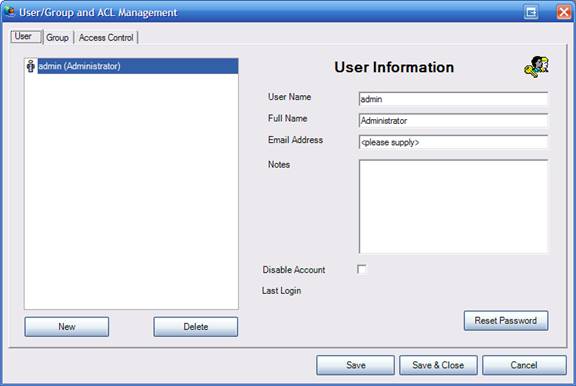
Settings à Administration à User Management
Use the User Administration applet to manage user accounts in your Gnosis system. Here you may manage individual users, groups and specific access rights (called Access Control Lists, or “ACL’s”.

When adding a new user, always supply the user’s full name, login name, email address, and also press the “Reset password” button to assign them an initial password.
You will also need to add new users to one of the groups defined on your system. Switch to the “Group” tab, select one or more groups that the user should belong to and add them to each group.
Finally, switch back to the user tab and select the primary group to be assigned for the user by choosing one of the groups in the drop down list for “primary group”.

The Access Control Levels (ACL) provides the Gnosis administrator the ability to ensure the integrity and security of data within the Gnosis system. Through the use of the varying degrees of access, users can be allowed to view, add, and/or update only the data within the purview of their responsibilities.
Capabilities
Each Gnosis system comes pre-configured with default capabilities. You may choose to change these capabilities to meet your specific needs.
Capabilities can be set at either a group or user level
Capabilities are additive which means that the least restrictive ACL setting used will be the access available to that user. For example, if General Database Access is set to Read/Write at the group level and Read at the user level, that specific user will have Read/Write access to the database.
Capabilities include:
|
------ |
This capability will defer to any other capability set at either the group or user level. Any single “ACL” set to ---- with no other capability set, means that the user WILL NOT have access to this ACL. |
|
Read |
The user has read access to this ACL |
|
Read/Write |
The user can read, create and update this ACL |
|
Administrative |
This ACL capability is not often used, but may be employed for specific ACLs and users that need broader access to certain parts of the database. |
|
ACL |
Description |
|
General Database Access |
Enables login access (basic use of the database) |
|
System Administration |
Allows use of the Administration Menu |
|
Person/Household Data Management |
Allows access to the Person/Household data |
|
Organization Data Management |
Allows access to the Organization data |
|
Communications Management |
Allows access to the Communications Module |
|
Recipient Group Access |
Allows access to read/ create/modify/ recipient groups to receive communications |
|
Document Template Access |
Allows access to create/ modify document templates |
|
User Administration |
Allows access to create/modify user accounts (usually managed by the Gnosis administrator ) |
|
Reporting Access |
Allows access to the reporting module |
|
Attribute Management |
Allows access to create/modify attributes (usually Gnosis administrator) |
|
Reference Data Management |
Allows access to create/modify reference data (usually Gnosis administrator) |
|
Update Org. Level Preferences |
Allows access to create/modify Organization Preferences in Settings & Preferences (usually Gnosis administrator) |
|
Updated Group Level Settings |
Allows access to create/modify Group Preferences in Settings & Preferences (usually Department Head or Group Manager) |
|
System Job Scheduler Access |
Allows access to create/modify schedules for reports, communications, etc. |
|
Contribution Management |
Allows access to contributions module |
|
Data Access ACLs |
If Implemented in the database, restricts or allows access to certain parts of the database (usually managed by the Gnosis administrator) |
|
Special ACLs |
|
|
SQL Code Access Level |
Allows access to create/modify sql queries in the Reporting Module |
|
Financial Systems Access |
Allows access to E-commerce Modules |
|
DACL Management |
If Data ACLs are implemented, allows those users who have access to a particular record to set rules for who else may access that record. |